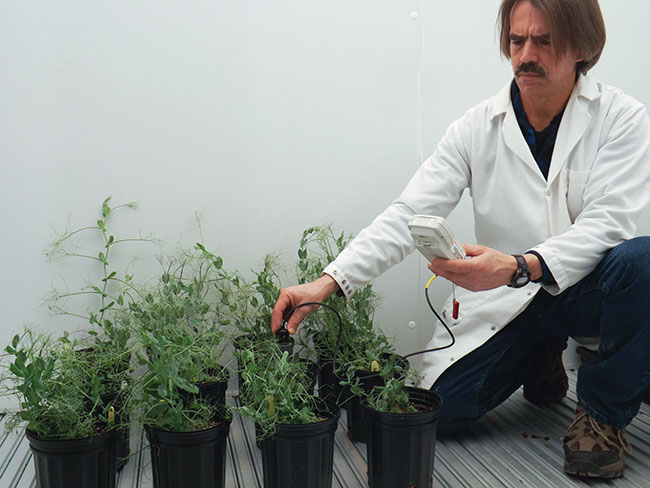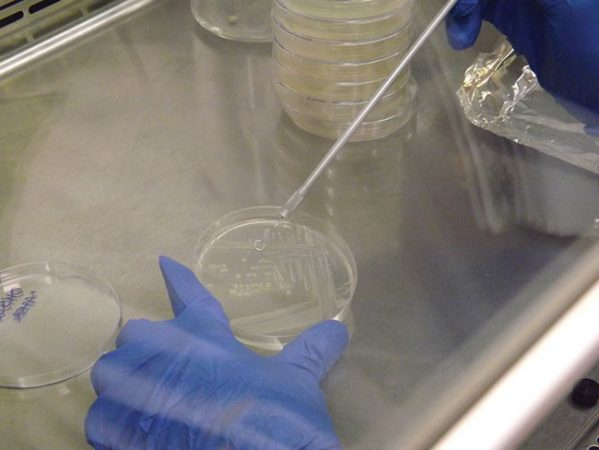
Features
Agronomy
Pulses
Modifying the rhizobia, instead of the pulse crop
In the future, your rhizobial inoculant might also deliver stress tolerance to your pulse crop.
March 16, 2022 By Carolyn King
 One of Goyal’s technicians measures soil moisture to
assess the effect of drought on plant growth and development. Photo courtesy of Ravinder Goyal.
One of Goyal’s technicians measures soil moisture to
assess the effect of drought on plant growth and development. Photo courtesy of Ravinder Goyal. A multitude of stresses ranging from disease to drought can have devastating impacts on crop yields. Pulse crop physiologist Ravinder Goyal decided to “think alternatively” to find a way to improve the ability of pulses to defend themselves against such stresses.
“Only very limited options are available to improve stress tolerance in pulse crops using traditional breeding strategies because the stress tolerance trait, without close linkage to an undesirable trait, has to be present in the germplasm,” says Goyal, a research scientist with the Lacombe Research and Development Centre of Agriculture and Agri-Food Canada in Alberta.
“Even if such a trait is present, the developed drought-tolerant cultivars are unlikely to perform better than superior elite cultivars under normal environmental conditions. Because of likely trade-off with yield, the drought-tolerant cultivars will outperform an elite cultivar only under drought conditions which cannot be predicted before planting.”
He notes, “The other option would be to use a transgenic approach to insert the genes of interest directly into the crop plant to realize the function of those genes.”
However, Alberta Pulse Growers’ executive director Leanne Fischbuch says, “Pulse farmers are committed to supplying high quality products that meet the needs of the marketplace, and the marketplace is not yet accepting of transgenics as a method to solve biotic or abiotic impacts on pulse yield.”
“So, I thought of leveraging the Rhizobium to do the job,” says Goyal. Since growers already apply inoculants of rhizobial bacteria to their pulse crops, he wondered if those microbial friends could take on another task.
“When we say rhizobial bacteria, the first thing that comes to mind is biological nitrogen fixation. In this partnership between the bacteria and the host plant, the bacteria use some nutrients from the plant, and they deliver the finished product in terms of fixed nitrogen, which can be used by the plant. In our research, we are asking the bacteria to deliver a little bit more of a different kind.”
He explains the concept: “Whenever certain genes are functionalized in any crop, whether that is through plant breeding or through a transgenic approach, their gene products turn on some of the metabolic reactions in the plant or synthesize certain products that allow the plant to defend itself against a certain kind of stress. The gene products are basically proteins.
“We want to change the rhizobial bacteria to deliver those same proteins, which otherwise would have been delivered by plant breeding approaches or transgenic approaches. Basically, we are making the Rhizobium into a delivery boy for us, to deliver something they do not usually deliver.”
So, the rhizobia would still deliver nitrogen to the host crop, but they would also deliver the means for the plant to tolerate the stress of interest.
Goyal’s current project is targeting drought stress in field pea, as a model to work out the details of this approach. He chose to focus on drought stress because it is already a serious problem for Prairie crop growers and will likely become an even greater problem in the years ahead as the climate warms. Field pea is a commonly grown pulse crop in Western Canada, and the plant forms a symbiotic partnership with Rhizobium leguminosarum biovar viciae, a bacterium that also forms symbiotic partnerships with several other pulse crop species.
Goyal and his research team will be using a gene editing approach to deliver certain proteins to the host that act as the master switches for the plant to turn on the genes which are responsible for drought tolerance.

Manipulation of Rhizobium leguminosarum for drought tolerance.
The researchers will be evaluating the effects of the modifications to the Rhizobium in the laboratory and the greenhouse, assessing how the changes affect the Rhizobium‘s performance and the host plant’s performance. “Our first priority will be to check that we have not compromised the rhizobia’s basic function in any way. They should be performing their nitrogen fixation function as well or nearly as well as usual, while they deliver other proteins of interest,” Goyal says. “Once we see that proof of concept has been obtained under both lab and greenhouse conditions, we would need to seek permission from the regulatory agencies for testing under field conditions.”
It could be a number of years before the research reaches the field-testing stage. The project’s progress in 2020 and 2021 has been slowed first by the pandemic lockdown and then by the ongoing pandemic-related restrictions to the number of people who can be present in the lab at any given time. And, of course, modifying the Rhizobium to enable drought tolerance in a pea plant is not a simple task.
“We have to make slow incremental progress; it may not be possible to leap from A to Z in just one jump. It is exciting but very challenging research,” he says.
Goyal believes that overcoming the challenges will definitely be worth the effort. “I’m very excited about this research because this technology has a very wide scope of application. Wherever the symbiotic partnership with rhizobia is present, not only field pea but any pulse crop, this approach can be applied,” he says.
“And, since a plant’s response to any type of stress is changed by the presence or absence of certain gene products, we can use this approach to defend our pulse plants against any type of stress – abiotic stresses like salinity or heat or cold, and biotic stresses like diseases. As a matter of fact, my next priority will be to find some solution against root rot which has been affecting pea growers very significantly.”
Goyal sees the potential for substantial benefits to pulse growers from this research. In economic terms, enabling a pulse crop to defend itself against stress helps protect yields. Plus, knowing that the crop has the means to defend itself against such threats can give the grower peace of mind.
This project is funded by Alberta Pulse Growers in partnership with Results Driven Agriculture Research (RDAR).